Protective Coating for Zinc Electrodes of Zinc–Air Battery in a Neutral Electrolyte
Abstract
1. Introduction
2. Materials and Methods
2.1. Materials
2.2. Electrochemical, Morphological and Spectroscopic Tests
3. Results
3.1. Electrochemical Tests
3.2. Charge/Discharge Tests
3.3. Morphological Studies
3.4. Spectroscopic Studies
3.5. XRD Studies
4. Conclusions
Author Contributions
Funding
Data Availability Statement
Conflicts of Interest
References
- Yuan, Z.; Yin, Y.; Xie, C.; Zhang, H.; Yao, Y.; Li, X. Advanced Materials for Zinc-Based Flow Battery: Development and Challenge. Adv. Mater. 2019, 31, 1902025. [Google Scholar] [CrossRef] [PubMed]
- Lu, W.; Xie, C.; Zhang, H.; Li, X. Zinc dendrites Inhibition for Zinc-based Battery. ChemSusChem 2018, 11, 1–12. [Google Scholar] [CrossRef] [PubMed]
- Wang, C.; Yu, Y.; Niu, J.; Liu, Y.; Bridges, D.; Liu, X.; Pooran, J.; Zhang, Y.; Hu, A. Recent Progress of Metal—Air Batteries—A Mini Review. Appl. Sci. 2019, 9, 2787. [Google Scholar] [CrossRef]
- Mele, C.; Bozzini, B. Spectroelectrochemical investigation of the anodic and cathodic behaviour of zinc in 5.3 M KOH. J. Appl. Electrochem. 2015, 45, 43–50. [Google Scholar] [CrossRef]
- Mele, C.; Bilotta, A.; Bocchetta, P.; Bozzini, B. Characterization of the particulate anode of a laboratory flow Zn–air fuel cell. J. Appl. Electrochem. 2017, 47, 877–888. [Google Scholar] [CrossRef]
- Bozzini, B.; Kazemian, M.; Kiskinova, M.; Kourousias, G.; Mele, C.; Gianoncelli, A. Operando soft X-ray microscope study of rechargeable Zn–air battery anodes in deep eutectic solvent electrolyte. X-Ray Spectrom. 2019, 48, 527–535. [Google Scholar] [CrossRef]
- Mu, T.; Lu, H.; Wang, H.; Wang, Y.; Lou, S.; Zhang, Y.; Gao, J.; Ma, Y.; Zuo, P.; Zhu, X.; et al. Artificial organic-inorganic hybrid interface enables reversible Zn anodes. Nano Energy 2025, 138, 110835. [Google Scholar] [CrossRef]
- Suppanucroa, N.; Yoopensuk, W.; Pimoei, J.; Thanapong-a-morn, W.; Kao-Ian, W.; Pakawanit, P.; Mahlendorf, F.; Kheawhom, S.; Somwangthanaroj, A. Enhanced long-term stability of zinc-air batteries using a quaternized PVA-chitosan composite separator with thin-layered MoS2. Electrochim. Acta 2025, 510, 145361. [Google Scholar] [CrossRef]
- Shinde, S.S.; Kim, S.H.; Wagh, N.K.; Lee, J.H. Design Strategies for Practical Zinc-Air Batteries Toward Electric Vehicles and beyond. Adv. Energy Mater. 2025, 15, 2405326. [Google Scholar] [CrossRef]
- Wang, Y.; Kwok, H.; Pan, W.; Zhang, H.; Leung, D.Y.C. Innovative paper-based Al-air batteries as a low-cost and green energy technology for the miniwatt market. J. Power Sources 2019, 414, 278–282. [Google Scholar] [CrossRef]
- Mainar, A.R.; Leonet, O.; Bengoechea, M.; Boyano, I.; de Meatza, I.; Kvasha, A.; Guerfi, A.; Blázquez, J.A. Alkaline aqueous electrolytes for secondary zinc–air batteries: An overview. Int. J. Energy Res. 2016, 40, 1032–1049. [Google Scholar] [CrossRef]
- Linden, D.; Reddy, T.B. Handbook of Batteries, 3rd ed.; TRD McGraw-Hill: Singapore, 2002. [Google Scholar]
- Bozzini, B.; Altissimo, M.; Amati, M.; Bocchetta, P.; Gianoncelli, A.; Gregoratti, L.; Kourousias, G.; Mancini, L.; Mele, C.; Kiskinova, M. In situ and ex situ X-ray microspectroelectrochemical methods for the study of zinc-air batteries. Encycl. Interfacial Chem. Surf. Sci. Electrochem. 2018, 174–194. [Google Scholar] [CrossRef]
- Bozzini, B.; Mele, C.; Veneziano, A.; Sodini, N.; Lanzafame, G.; Taurino, A.; Mancini, L. Morphological Evolution of Zn-Sponge Electrodes Monitored by in Situ X-ray Computed Microtomography. ACS Appl. Energy Mater. 2020, 3, 4931–4940. [Google Scholar] [CrossRef]
- Zhao, H. Recent Advances in Rechargeable Zn-Air Batteries. Molecules 2024, 29, 5313. [Google Scholar] [CrossRef]
- Durmus, Y.E.; Guerrero, S.S.M.; Tempel, H.; Hausen, F.; Kungl, H.; Eichel, R.A. Influence of Al Alloying on the Electrochemical Behavior of Zn Electrodes for Zn–Air Batteries with Neutral Sodium Chloride Electrolyte. Front. Chem. 2019, 7, 800. [Google Scholar] [CrossRef]
- Guerrero, S.S.M.; Durmus, Y.E.; Dzieciol, K.; Basak, S.; Tempel, H.; van Waasen, S.; Kungl, H.; Eichel, R.A. Improved Electrochemical Performance of Zinc Anodes by EDTA in Near-Neutral Zinc−Air Batteries. Batter. Supercaps 2021, 4, 1830–1842. [Google Scholar] [CrossRef]
- Wei, W.; Xu, J.; Chen, W.; Mi, L.; Zhang, J. A review of sodium chloride-based electrolytes and materials for electrochemical energy technology. J. Mater. Chem. A 2022, 10, 2637–2671. [Google Scholar] [CrossRef]
- Jindra, J.; Mrha, J.; Musilová, M. Zinc-air cell with neutral electrolyte. J. Appl. Electrochem. 1973, 3, 297–301. [Google Scholar] [CrossRef]
- Amendola, S.; Binder, M.; Black, P.J.; Sharp-Goldman, S.; Johnson, L.; Kunz, M.; Oster, M.; Chciuk, T.; Johnson, R. Electrically Rechargeable, Metal-Air Battery Systems and Methods. US Patent US20120021303A1, 26 January 2012. [Google Scholar]
- Goh, F.W.T.; Liu, Z.; Hor, T.S.A.; Zhang, J.; Ge, X.; Zong, Y.; Yu, A.; Khoo, W. A Near-Neutral Chloride Electrolyte for Electrically Rechargeable Zinc-Air Batteries. J. Electrochem. Soc. 2014, 161, A2080–A2086. [Google Scholar] [CrossRef]
- Sumboja, A.; Ge, X.; Zheng, G.; Goh, F.W.T.; Hor, T.S.A.; Zong, Y.; Liu, Z. Durable rechargeable zinc-air batteries with neutral electrolyte and manganese oxide catalyst. J. Power Sources 2016, 332, 330–336. [Google Scholar] [CrossRef]
- Clark, S.; Latz, A.; Horstmann, B. Rational Development of Neutral Aqueous Electrolytes for Zinc–Air Batteries. ChemSusChem 2017, 10, 4735–4747. [Google Scholar] [CrossRef]
- Yu, J.; Zhao, C.-X.; Liu, J.-N.; Li, B.-Q.; Tang, C.; Zhang, Q. Seawater-based electrolyte for zinc–air batteries. Green. Chem. Eng. 2020, 1, 117–123. [Google Scholar] [CrossRef]
- Neburchilov, V.; Wang, H.; Martin, J.J.; Qu, W. A review on air cathodes for zinc-air fuel cells. J. Power Sources 2010, 195, 1271–1291. [Google Scholar] [CrossRef]
- Gu, P.; Zheng, M.; Zhao, Q.; Xiao, X.; Xue, H.; Pang, H. Rechargeable zinc-air batteries: A promising way to green energy. J. Mater. Chem. A 2017, 5, 7651–7666. [Google Scholar] [CrossRef]
- Cao, R.; Lee, J.S.; Liu, M.; Cho, J. Recent progress in non-precious catalysts for metal-air batteries. Adv. Energy Mater. 2012, 2, 816–829. [Google Scholar] [CrossRef]
- Xue, G.; Bian, H.; Wang, B.; Wu, H.; Li, F.; Wang, C.; Zhou, Q.; Jia, S.; Hu, Z.; Ma, Y.; et al. An organic-inorganic composite coating with excellent protection and ion regulation effects for highly stable zinc anodes. Colloids Surf. A Physicochem. Eng. Asp. 2024, 703, 135272. [Google Scholar] [CrossRef]
- Li, B.; Yang, H.; He, J.; Yu, S.; Xiao, R.; Luo, H.; Wen, Y.; Peng, S.; Liao, X.; Yang, D. Photopolymerization of Coating Materials for Protection against Carbon Steel Corrosion. Materials 2023, 16, 2015. [Google Scholar] [CrossRef]
- Corcione, C.E.; Striani, R.; Frigione, M. Organic-inorganic UV-cured methacrylic-based hybrids as protective coatings for different substrates. Prog. Org. Coat. 2014, 77, 1117–1125. [Google Scholar] [CrossRef]
- Striani, R.; Cappai, M.; Casnedi, L.; Corcione, C.E.; Pia, G. Coating’s influence on wind erosion of porous stones used in the Cultural Heritage of Southern Italy: Surface characterisation and resistance. Case Stud. Constr. Mater. 2022, 17, e01501. [Google Scholar] [CrossRef]
- Pia, G.; Corcione, C.E.; Striani, R.; Casnedi, L.; Sanna, U. Coating’s influence on water vapour permeability of porous stones typically used in cultural heritage of Mediterranean area: Experimental tests and model controlling procedure. Prog. Org. Coat. 2017, 102, 239–246. [Google Scholar] [CrossRef]
- Striani, R.; Corcione, C.E.; Muia, G.D.; Frigione, M. Durability of a sunlight-curable organic–inorganic hybrid protective coating for porous stones in natural and artificial weathering conditions. Prog. Org. Coat. 2016, 101, 1–14. [Google Scholar] [CrossRef]
- Fouassier, J.P. An introduction to the basic principles in UV-curing. Radiat. Curing Polym. Sci. Technol. 1993, 1, 49–113. [Google Scholar]
- Corcione, C.E.; Frigione, M.; Striani, R. Hybrid Organic-Inorganic Nanostructured UV-Curable Formulation and Method for Preparation Thereof. European Patent 13001868.2, 11 April 2013. [Google Scholar]
- Bozzini, B.; Bagheri, S.; Boniardi, M.; Mancini, L.; Marini, E.; Sgura, I.; Mele, C. Quantifying and rationalizing polarization curves of Zn-air fuel-cells: A simple enabling contribution to device-scale analysis and monitoring. Electrochim. Acta 2022, 425, 140712. [Google Scholar] [CrossRef]
- Mele, C.; Bozzini, B. Corrosion performance of austenitic stainless steel bipolar plates for Nafion- and room-temperature ionic-liquid-based PEMFCs. Open Fuels Energy Sci. J. 2012, 5, 47–52. [Google Scholar] [CrossRef]
- Pakshir, M.; Bagheri, T.; Kazemi, M.R. In vitro evaluation of the electrochemical behaviour of stainless steel and Ni-Ti orthodontic archwires at different temperatures. Eur. J. Orthod. 2013, 35, 407–413. [Google Scholar] [CrossRef] [PubMed]
- Meng, Y.; Liu, L.; Zhang, D.; Dong, C.; Yan, Y.; Volinsky, A.A.; Wang, L.N. Initial formation of corrosion products on pure zinc in saline solution. Bioact. Mater. 2019, 4, 87–96. [Google Scholar] [CrossRef]
- Ahaliabadeh, Z.; Miikkulainen, V.; Mäntymäki, M.; Mousavihashemi, S.; Lahtinen, J.; Lide, Y.; Jiang, H.; Mizohata, K.; Kankaanpää, T.; Kallio, T. Understanding the Stabilizing Effects of Nanoscale Metal Oxide and Li-Metal Oxide Coatings on Lithium-Ion Battery Positive Electrode Materials. ACS Appl. Mater. Interfaces 2021, 13, 42773–42790. [Google Scholar] [CrossRef]
- Duchoslav, J.; Steinberger, R.; Arndt, M.; Keppert, T.; Luckeneder, G.; Stellnberger, K.H.; Hagler, J.; Angeli, G.; Riener, C.K.; Stifter, D. Evolution of the surface chemistry of hot dip galvanized Zn-Mg-Al and Zn coatings on steel during short term exposure to sodium chloride containing environments. Corros. Sci. 2015, 91, 311–320. [Google Scholar] [CrossRef]
- Liu, L.; Li, P.; Zou, Y.; Luo, K.; Zhang, F.; Zeng, R.C.; Li, S. In vitro corrosion and antibacterial performance of polysiloxane and poly(acrylic acid)/gentamicin sulfate composite coatings on AZ31 alloy. Surf. Coat. Technol. 2016, 291, 7–14. [Google Scholar] [CrossRef]
- Liu, J.C.; Park, S.W.; Nagao, S.; Nogi, M.; Koga, H.; Ma, J.S.; Zhang, G.; Suganuma, K. The role of Zn precipitates and Cl- anions in pitting corrosion of Sn-Zn solder alloys. Corros. Sci. 2015, 92, 263–271. [Google Scholar] [CrossRef]
- Longhi, M.; Kunsta, S.R.; Beltrami, L.V.R.; Kerstner, E.K.; Filho, C.I.S.; Sarmento, V.H.V.; Malfatti, C. Effect of tetraethoxy-silane (TEOS) amounts on the corrosion prevention properties of siloxane-pmma hybrid coatings on galvanized steel substrates. Mater. Res. 2015, 18, 1140–1155. [Google Scholar] [CrossRef]
- Figueira, R.B.; Silva, C.J.R.; Pereira, E.V. Organic–inorganic hybrid sol–gel coatings for metal corrosion protection: A review of recent progress. J. Coat. Technol. Res. 2015, 12, 1–35. [Google Scholar] [CrossRef]
- Harb, S.V.; Trentin, A.; Torrico, R.F.O.; Pulcinelli, S.H.; Santilli, C.V.; Hammer, P. Organic-Inorganic Hybrid Coatings for Corrosion Protection of Metallic Surfaces. New Technol. Prot. Coat. 2017, 290, 153–162. [Google Scholar] [CrossRef]
- Fan, X.; Liu, J.; Song, Z.; Han, X.; Deng, Y.; Zhong, C.; Hu, W. Porous nanocomposite gel polymer electrolyte with high ionic conductivity and superior electrolyte retention capability for long-cycle-life flexible zinc–air batteries. Nano Energy 2019, 56, 454–462. [Google Scholar] [CrossRef]
- Li, Q.; Chen, A.; Wang, D.; Pei, Z.; Zhi, C. “Soft Shorts” Hidden in Zinc Metal Anode Research. Joule 2022, 6, 273–279. [Google Scholar] [CrossRef]
- Fuchs, D.; Müller, C.; Schaffeld, M.; Mahlendorf, F.; Hoster, H.E. New Insights Into Zinc Passivation Through Operando Measured Zincate Concentrations. Batter. Supercaps 2024, 7, e202400298. [Google Scholar] [CrossRef]
- Bockelmann, M.; Reining, L.; Kunz, U.; Turek, T. Electrochemical characterization and mathematical modeling of zinc passivation in alkaline solutions: A review. Electrochim. Acta 2017, 237, 276–298. [Google Scholar] [CrossRef]
- Zhang, Y.; Zheng, X.; Wang, N.; Lai, W.H.; Liu, Y.; Chou, S.L.; Liu, H.K.; Dou, S.X.; Wang, Y.X. Anode optimization strategies for aqueous zinc-ion batteries. Chem. Sci. 2022, 13, 14246–14263. [Google Scholar] [CrossRef]
- Nikitenko, V.A.; Plekhanov, V.G.; Mukhin, S.V. Raman Spectra of Oxide zinc powder and single crystals. J. Appl. Spectrosc. 1996, 63, 350–352. [Google Scholar] [CrossRef]
- Gu, R.A.; Shen, X.Y.; Liu, G.K.; Ren, B.; Tian, Z.Q. Surface-enhanced raman scattering from bare Zn electrode. J. Phys. Chem. B 2004, 108, 17519–17522. [Google Scholar] [CrossRef]
- Cai, D.; Neyer, A.; Kuckuk, R.; Heise, H.M. Raman, mid-infrared, near-infrared and ultraviolet-visible spectroscopy of PDMS silicone rubber for characterization of polymer optical waveguide materials. J. Mol. Struct. 2010, 976, 274–281. [Google Scholar] [CrossRef]
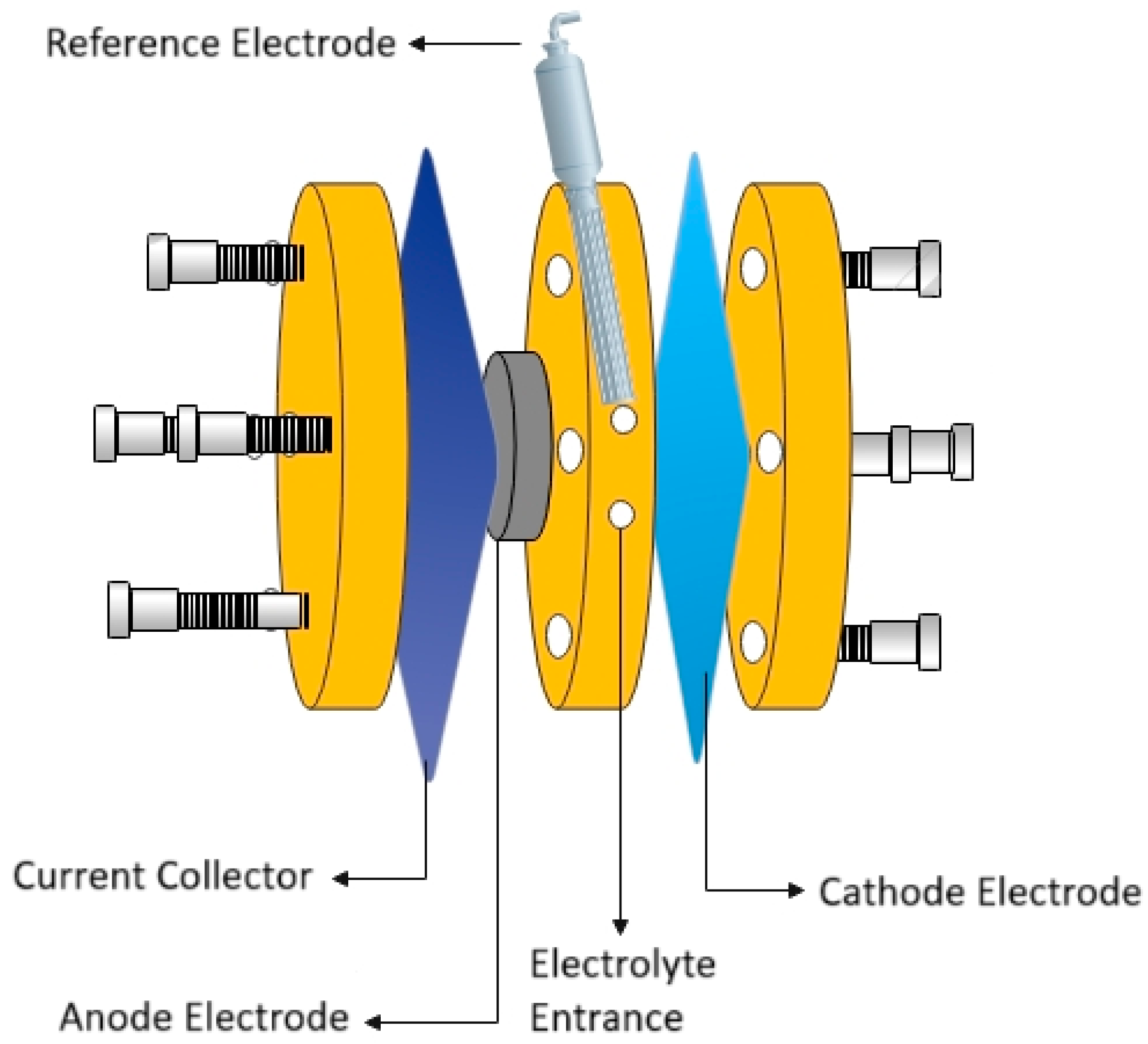
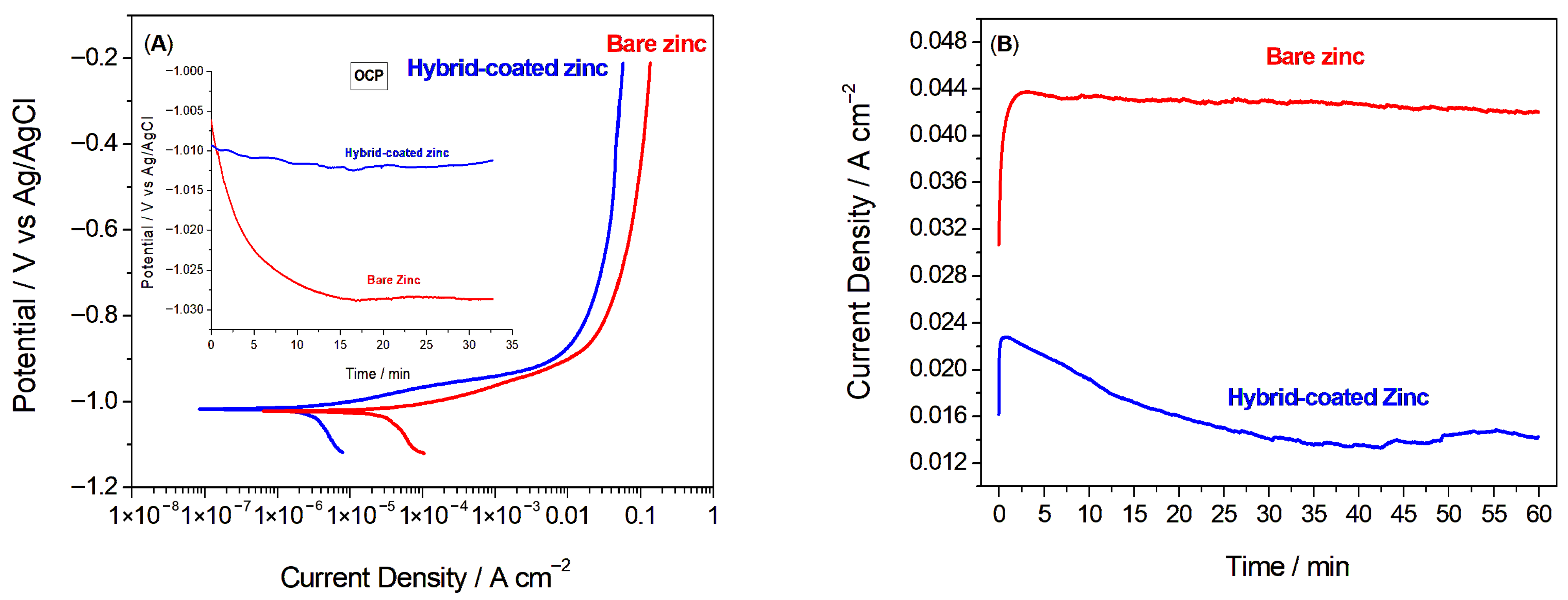
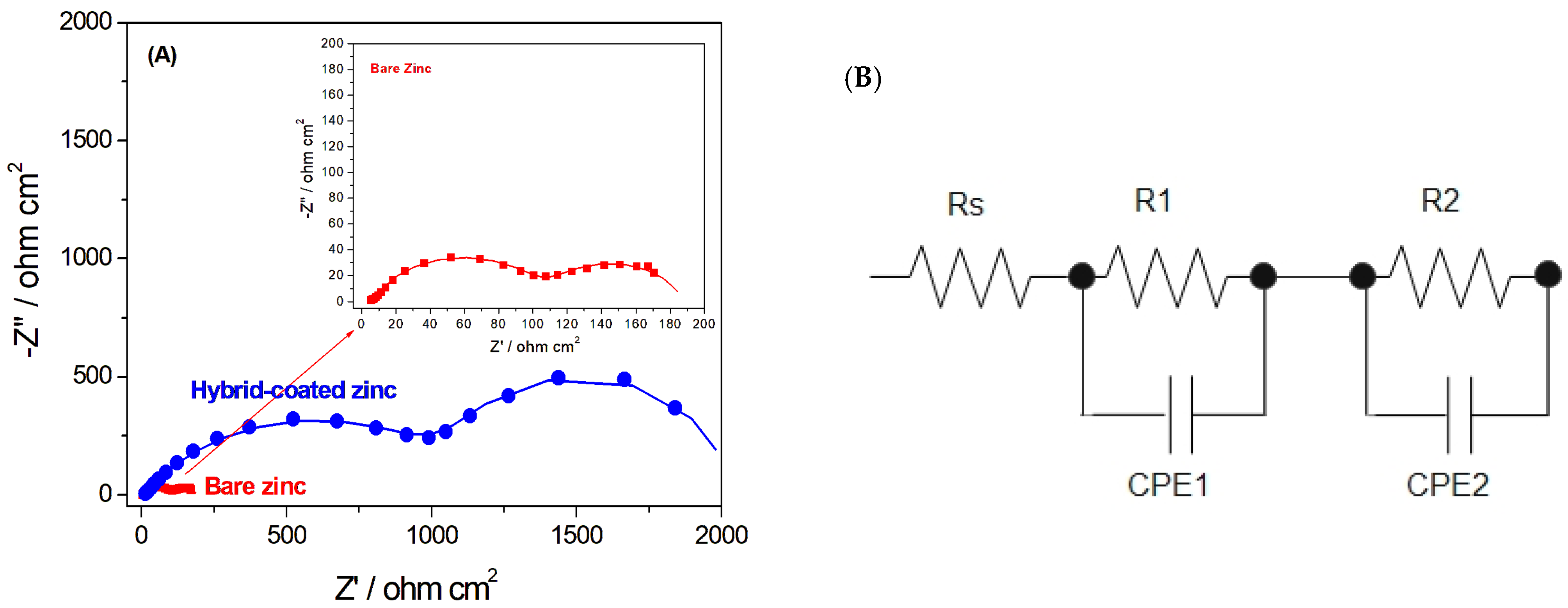
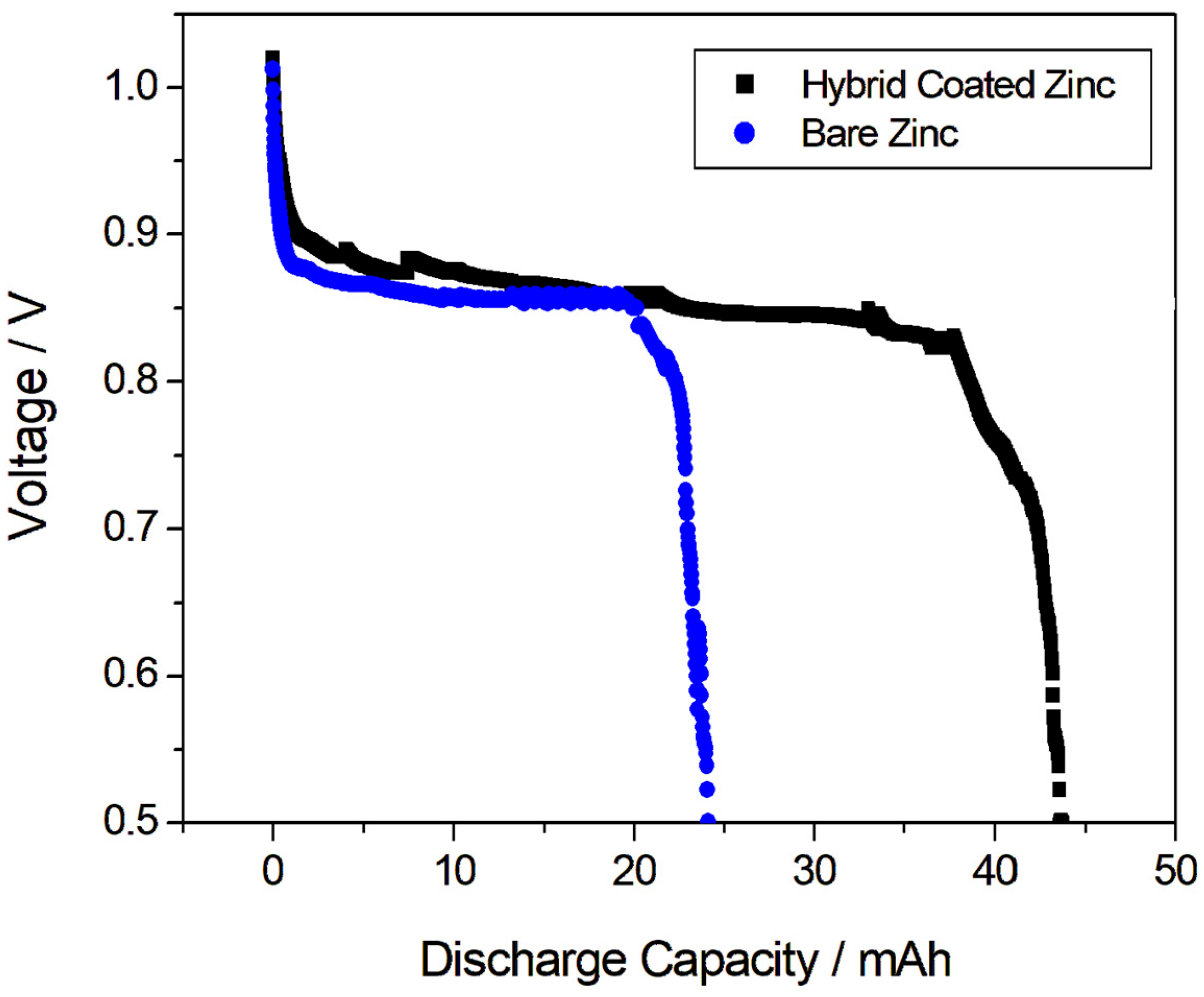
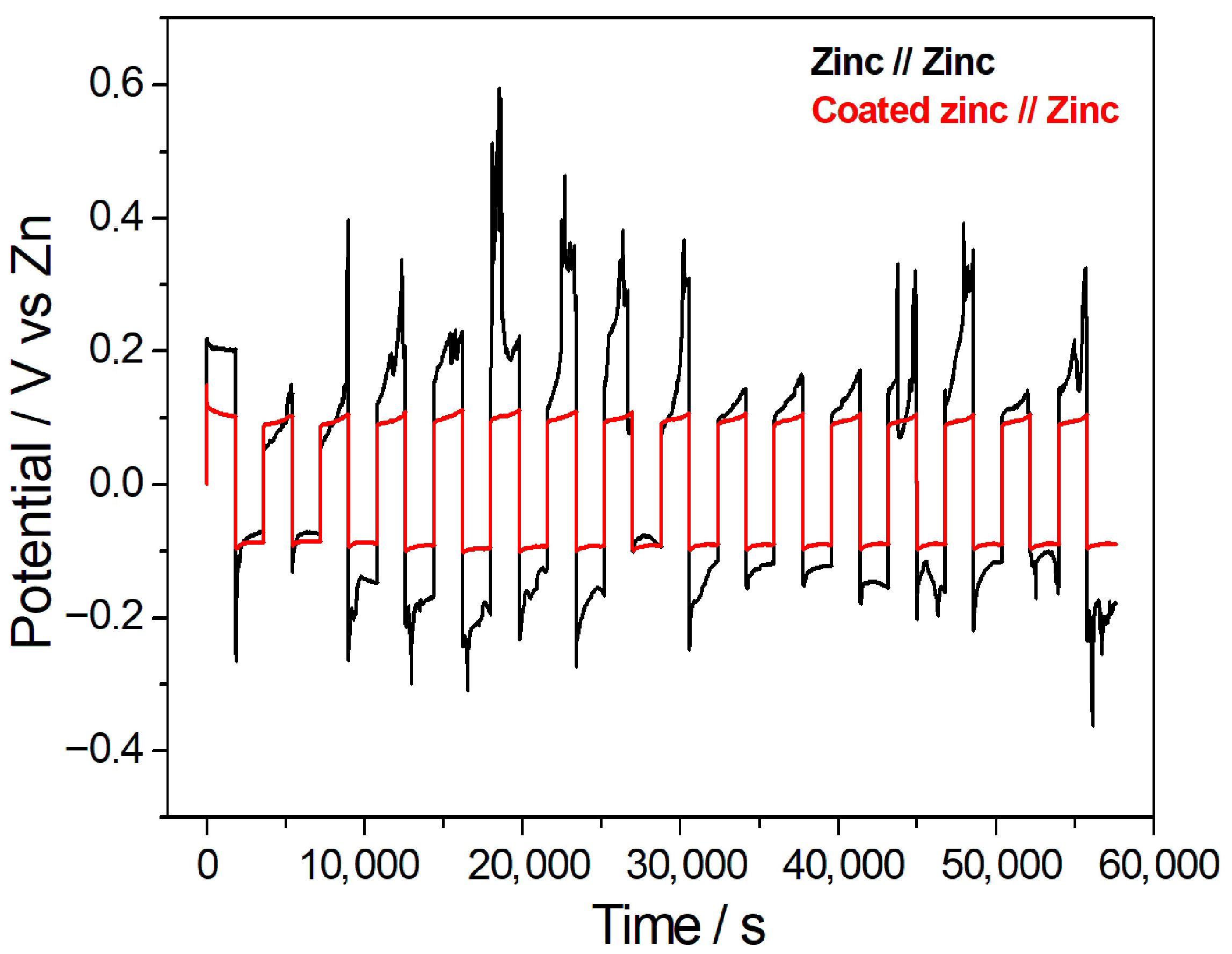
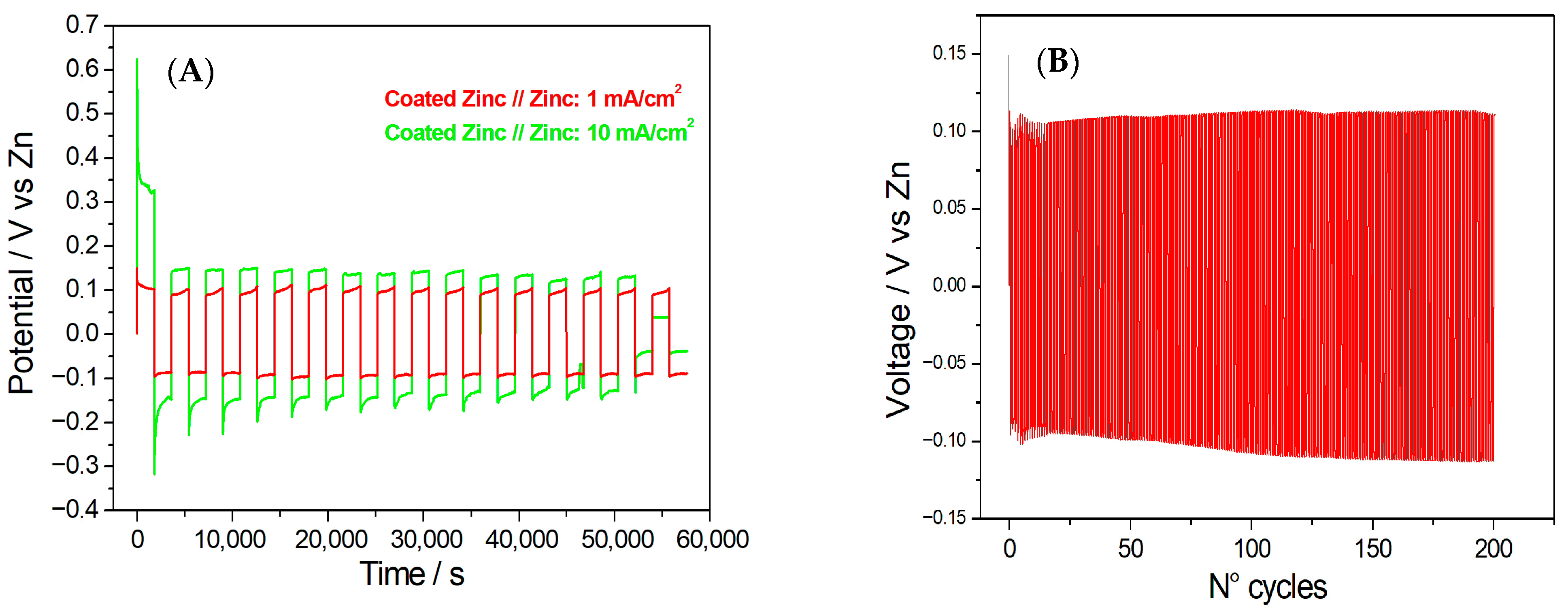

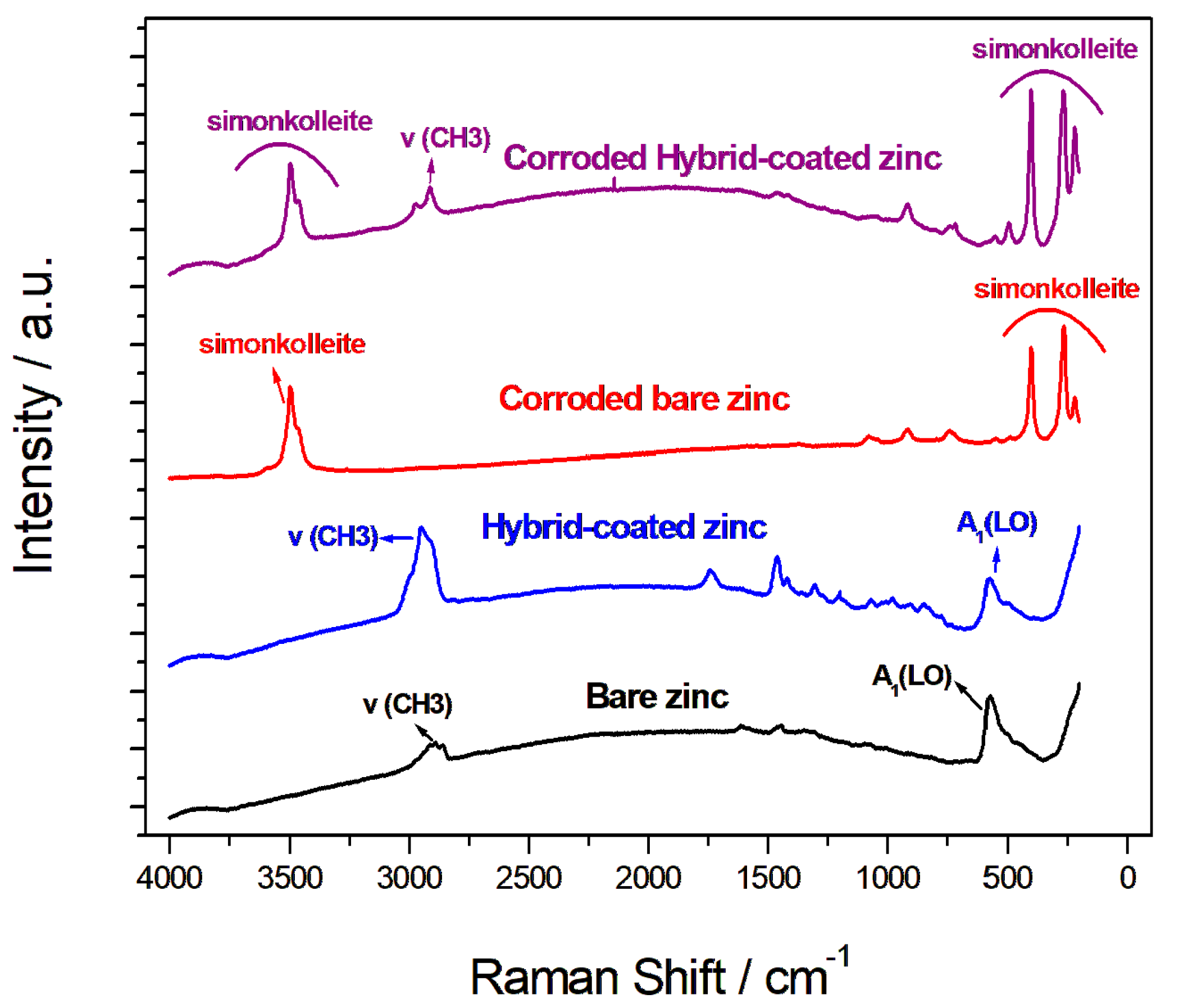

| Sample | Rs (Ω·cm2) | R1 (Ω·cm2) | R2 (Ω·cm2) | CPE1 | CPE2 | ||
|---|---|---|---|---|---|---|---|
| Y1 (Ω−1 cm−1 sn) | n1 | Y2 (Ω−1 cm−1 sn) | n2 | ||||
| Bare Zinc | 6.04 ± 0.17 | 102.2 ± 7.93 | 79.9 ± 24.32 | 0.000162 ± 3.47 × 10−5 | 0.72 ± 0.015 | 0.01216 ± 0.008 | 0.77 ± 0.15 |
| Hybrid-coated Zinc | 12.11 ± 0.32 | 998 ± 29.89 | 899.5 ± 81.97 | 0.0000437 ± 2.15 × 10−6 | 0.63 ± 0.005 | 0.00108 ± 0.000157 | 0.90 ± 0.061 |
| Sample | Rq (nm) |
|---|---|
| Bare Zinc | 2.99 ± 1.04 |
| Hybrid-Coated Zinc | 1.01 ± 0.37 |
| Corroded Bare Zinc | 32.52 ± 14.45 |
| Corroded Hybrid-coated Zinc | 2.28 ± 0.72 |
Disclaimer/Publisher’s Note: The statements, opinions and data contained in all publications are solely those of the individual author(s) and contributor(s) and not of MDPI and/or the editor(s). MDPI and/or the editor(s) disclaim responsibility for any injury to people or property resulting from any ideas, methods, instructions or products referred to in the content. |
© 2025 by the authors. Licensee MDPI, Basel, Switzerland. This article is an open access article distributed under the terms and conditions of the Creative Commons Attribution (CC BY) license (https://creativecommons.org/licenses/by/4.0/).
Share and Cite
Bagheri, S.; Bozzini, B.; Corcione, C.E.; Striani, R.; Mele, C. Protective Coating for Zinc Electrodes of Zinc–Air Battery in a Neutral Electrolyte. Energies 2025, 18, 5599. https://doi.org/10.3390/en18215599
Bagheri S, Bozzini B, Corcione CE, Striani R, Mele C. Protective Coating for Zinc Electrodes of Zinc–Air Battery in a Neutral Electrolyte. Energies. 2025; 18(21):5599. https://doi.org/10.3390/en18215599
Chicago/Turabian StyleBagheri, Sonia, Benedetto Bozzini, Carola Esposito Corcione, Raffaella Striani, and Claudio Mele. 2025. "Protective Coating for Zinc Electrodes of Zinc–Air Battery in a Neutral Electrolyte" Energies 18, no. 21: 5599. https://doi.org/10.3390/en18215599
APA StyleBagheri, S., Bozzini, B., Corcione, C. E., Striani, R., & Mele, C. (2025). Protective Coating for Zinc Electrodes of Zinc–Air Battery in a Neutral Electrolyte. Energies, 18(21), 5599. https://doi.org/10.3390/en18215599










